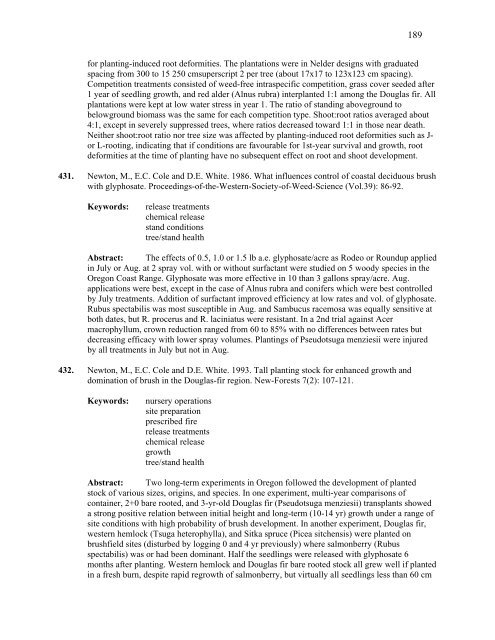IntensIve sIlvIculture - Forest Science Labs - Research Network ...
IntensIve sIlvIculture - Forest Science Labs - Research Network ...
IntensIve sIlvIculture - Forest Science Labs - Research Network ...
Create successful ePaper yourself
Turn your PDF publications into a flip-book with our unique Google optimized e-Paper software.
189<br />
for planting-induced root deformities. The plantations were in Nelder designs with graduated<br />
spacing from 300 to 15 250 cmsuperscript 2 per tree (about 17x17 to 123x123 cm spacing).<br />
Competition treatments consisted of weed-free intraspecific competition, grass cover seeded after<br />
1 year of seedling growth, and red alder (Alnus rubra) interplanted 1:1 among the Douglas fir. All<br />
plantations were kept at low water stress in year 1. The ratio of standing aboveground to<br />
belowground biomass was the same for each competition type. Shoot:root ratios averaged about<br />
4:1, except in severely suppressed trees, where ratios decreased toward 1:1 in those near death.<br />
Neither shoot:root ratio nor tree size was affected by planting-induced root deformities such as J-<br />
or L-rooting, indicating that if conditions are favourable for 1st-year survival and growth, root<br />
deformities at the time of planting have no subsequent effect on root and shoot development.<br />
431. Newton, M., E.C. Cole and D.E. White. 1986. What influences control of coastal deciduous brush<br />
with glyphosate. Proceedings-of-the-Western-Society-of-Weed-<strong>Science</strong> (Vol.39): 86-92.<br />
Keywords: release treatments<br />
chemical release<br />
stand conditions<br />
tree/stand health<br />
Abstract: The effects of 0.5, 1.0 or 1.5 lb a.e. glyphosate/acre as Rodeo or Roundup applied<br />
in July or Aug. at 2 spray vol. with or without surfactant were studied on 5 woody species in the<br />
Oregon Coast Range. Glyphosate was more effective in 10 than 3 gallons spray/acre. Aug.<br />
applications were best, except in the case of Alnus rubra and conifers which were best controlled<br />
by July treatments. Addition of surfactant improved efficiency at low rates and vol. of glyphosate.<br />
Rubus spectabilis was most susceptible in Aug. and Sambucus racemosa was equally sensitive at<br />
both dates, but R. procerus and R. laciniatus were resistant. In a 2nd trial against Acer<br />
macrophyllum, crown reduction ranged from 60 to 85% with no differences between rates but<br />
decreasing efficacy with lower spray volumes. Plantings of Pseudotsuga menziesii were injured<br />
by all treatments in July but not in Aug.<br />
432. Newton, M., E.C. Cole and D.E. White. 1993. Tall planting stock for enhanced growth and<br />
domination of brush in the Douglas-fir region. New-<strong>Forest</strong>s 7(2): 107-121.<br />
Keywords: nursery operations<br />
site preparation<br />
prescribed fire<br />
release treatments<br />
chemical release<br />
growth<br />
tree/stand health<br />
Abstract: Two long-term experiments in Oregon followed the development of planted<br />
stock of various sizes, origins, and species. In one experiment, multi-year comparisons of<br />
container, 2+0 bare rooted, and 3-yr-old Douglas fir (Pseudotsuga menziesii) transplants showed<br />
a strong positive relation between initial height and long-term (10-14 yr) growth under a range of<br />
site conditions with high probability of brush development. In another experiment, Douglas fir,<br />
western hemlock (Tsuga heterophylla), and Sitka spruce (Picea sitchensis) were planted on<br />
brushfield sites (disturbed by logging 0 and 4 yr previously) where salmonberry (Rubus<br />
spectabilis) was or had been dominant. Half the seedlings were released with glyphosate 6<br />
months after planting. Western hemlock and Douglas fir bare rooted stock all grew well if planted<br />
in a fresh burn, despite rapid regrowth of salmonberry, but virtually all seedlings less than 60 cm
















